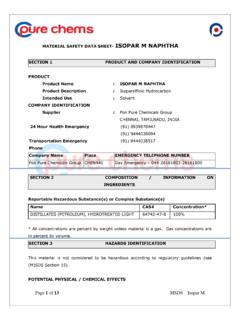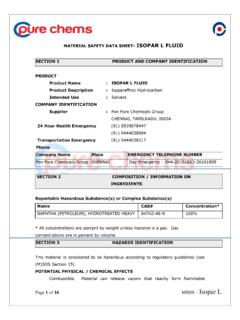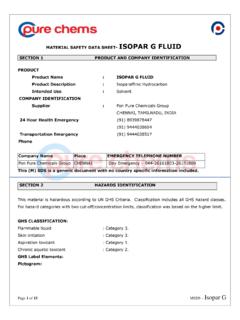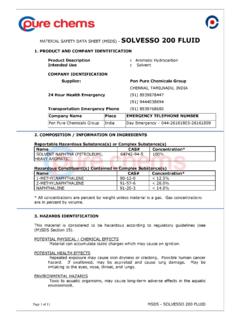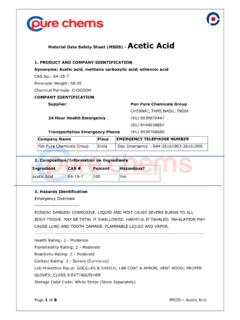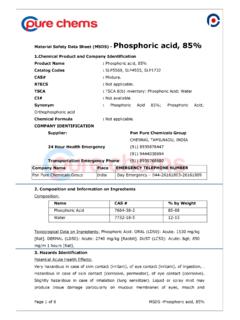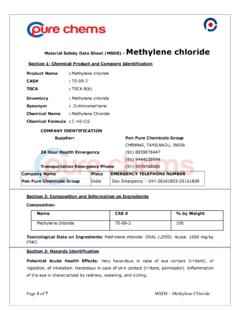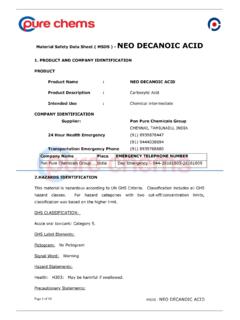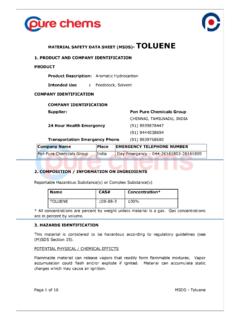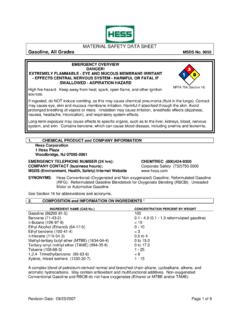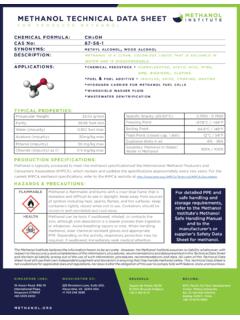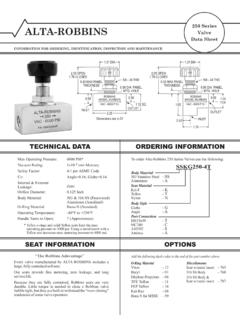Transcription of MATERIAL SAFETY DATA SHEET- (MSDS) METHYL TERT …
1 MSDS: METHLY TERT-BUTYL ETHER Page 1 of 8 MATERIAL SAFETY data sheet - (MSDS) METHYL TERT-BUTYL ETHER 1. Product Identification Synonyms : 2-Methoxy-2-methylpropane; tert-Butyl METHYL ether; METHYL 1,1-dimethyl ethyl ether; mtbe CAS No. : 1634-04-4 Molecular Weight : Chemical Formula : C5H12O COMPANY IDENTIFICATION Supplier: Pon Pure Chemicals Group CHENNAI, TAMILNADU, INDIA 24 Hour Health Emergency (91) 8939878447 (91) 9444038694 Transportation Emergency Phone (91) 8939768680 Company Name Place EMERGENCY TELEPHONE NUMBER Pon Pure Chemicals Group India Day Emergency 044-26161803-26161809 2. Composition/Information on Ingredients 3. Hazards Identification Emergency Overview DANGER! EXTREMELY FLAMMABLE LIQUID AND VAPOR. VAPOR MAY CAUSE FLASH FIRE.
2 HARMFUL IF SWALLOWED, INHALED OR ABSORBED THROUGH SKIN. MAY AFFECT CENTRAL NERVOUS SYSTEM, BLOOD, AND KIDNEYS. A CENTRAL NERVOUS SYSTEM DEPRESSANT. CAUSES IRRITATION TO SKIN, EYES AND RESPIRATORY TRACT. SAF-T- data (tm) Ratings (Provided here for your convenience) Health Rating : 2 - Moderate (Life) Flammability Rating : 3 - Severe (Flammable) Reactivity Rating : 1 - Slight Contact Rating : 2 - Moderate (Life) Lab Protective Equip : GOGGLES LAB COAT VENT Ingredient CAS # Percent Hazardous? METHYL tert-butyl Ether 1634-04-4 99 - 100% Yes MSDS: METHLY TERT-BUTYL ETHER Page 2 of 8 HOOD; PROPER GLOVES; CLASS B EXTINGUISHER Storage Color Code : Red (Flammable) Potential Health Effects Inhalation: Inhalation of vapor can irritate respiratory tract. Causes central nervous system effects.
3 Breathing high concentrations in air can cause lightheadedness, dizziness, weakness, nausea, headache. Ingestion: May cause nausea, vomiting. Other symptoms similar to inhalation may occur. Laryngeal, ocular, and respiratory muscles are affected in severe poisoning. Skin Contact: A mild skin irritant which causes loss of natural oils. May be a route of absorption into the body. Eye Contact: Vapors can irritate eyes; splashes may cause damage to eye tissue. Chronic Exposure: Symptoms noted above may be produced by cumulative exposure. Aggravation of Pre-existing Conditions: Persons with pre-existing skin disorders or eye problems or impaired respiratory function may be more susceptible to the effects of the substance. 4. First Aid Measures Inhalation: Remove to fresh air. If not breathing, give artificial respiration.
4 If breathing is difficult, give oxygen. Call a physician. Ingestion: Induce vomiting immediately as directed by medical personnel. Never give anything by mouth to an unconscious person. Get medical attention. Skin Contact: Remove any contaminated clothing. Wash skin with soap and water for at least 15 minutes. Get medical attention if irritation develops or persists. Eye Contact: Immediately flush eyes with plenty of water for at least 15 minutes, lifting lower and upper eyelids occasionally. Get medical attention immediately. 5. Fire Fighting Measures Fire: Flash point : -27C (-17F) MSDS: METHLY TERT-BUTYL ETHER Page 3 of 8 Autoignition temperature : 435C (815F) Flammable limits in air % by volume : lel: ; uel: Extremely Flammable Liquid and Vapor! Vapor may cause flash fire.
5 Explosion: Above the flash point, explosive vapor-air mixtures may be formed. Vapors can flow along surfaces to distant ignition source and flash back. Sealed containers may rupture when heated. Sensitive to static discharge. Fire Extinguishing Media: Water spray, dry chemical, alcohol foam, or carbon dioxide. Water spray may be used to keep fire exposed containers cool. Special Information: In the event of a fire, wear full protective clothing and NIOSH-approved self-contained breathing apparatus with full face piece operated in the pressure demand or other positive pressure mode. 6. Accidental Release Measures Ventilate area of leak or spill. Remove all sources of ignition. Wear appropriate personal protective equipment as specified in Section 8. Isolate hazard area. Keep unnecessary and unprotected personnel from entering.
6 Contain and recover liquid when possible. Use non-sparking tools and equipment. Collect liquid in an appropriate container or absorb with an inert MATERIAL (e. g., vermiculite, dry sand, earth), and place in a chemical waste container. Do not use combustible materials, such as saw dust. Do not flush to sewer! If a leak or spill has not ignited, use water spray to disperse the vapors, to protect personnel attempting to stop leak, and to flush spills away from exposures. US Regulations (CERCLA) require reporting spills and releases to soil, water and air in excess of reportable quantities. The toll free number for the US Coast Guard National Response Center is (800) 424-8802. 7. Handling and Storage Protect against physical damage.
7 Store in a cool, dry well-ventilated location, away from any area where the fire hazard may be acute. Outside or detached storage is preferred. Separate from incompatibles. Containers should be bonded and grounded for transfers to avoid static sparks. Storage and use areas should be No Smoking areas. Use non-sparking type tools and equipment, including explosion proof ventilation. Containers of this MATERIAL may be hazardous when empty since they retain product residues (vapors, liquid); observe all warnings and precautions listed for the product. 8. Exposure Controls/Personal Protection Airborne Exposure Limits: -ACGIH Threshold Limit Value (TLV): 50 ppm (TWA), A3 - Confirmed animal carcinogen MSDS: METHLY TERT-BUTYL ETHER Page 4 of 8 with unknown relevance to humans Ventilation System: A system of local and/or general exhaust is recommended to keep employee exposures below the Airborne Exposure Limits.
8 Local exhaust ventilation is generally preferred because it can control the emissions of the contaminant at its source, preventing dispersion of it into the general work area. Please refer to the ACGIH document, Industrial Ventilation, A Manual of Recommended Practices, most recent edition, for details. Use explosion-proof equipment. Personal Respirators (NIOSH Approved): If the exposure limit is exceeded and engineering controls are not feasible, a half-face organic vapor respirator may be worn for up to ten times the exposure limit, or the maximum use concentration specified by the appropriate regulatory agency or respirator supplier, whichever is lowest. A full-face piece organic vapor respirator may be worn up to 50 times the exposure limit, or the maximum use concentration specified by the appropriate regulatory agency or respirator supplier, whichever is lowest.
9 For emergencies or instances where the exposure levels are not known, use a full-face piece positive-pressure, air-supplied respirator. WARNING: Air-purifying respirators do not protect workers in oxygen-deficient atmospheres. Where respirators are required, you must have a written program covering the basic requirements in the OSHA respirator standard. These include training, fit testing, medical approval, cleaning, maintenance, cartridge change schedules, etc. See for details. Skin Protection: Wear impervious protective clothing, including boots, gloves, lab coat, apron or coveralls, as appropriate, to prevent skin contact. Eye Protection: Use chemical SAFETY goggles and/or a full face shield where splashing is possible. Maintain eye wash fountain and quick-drench facilities in work area.
10 9. Physical and Chemical Properties Appearance : Clear, colorless liquid. Odor : Characteristic ethereal odor. Solubility : g/100g of water. Specific Gravity : pH : No information found. % Volatiles by volume @ 21C (70F): 100 Boiling Point : 55C (131F) Melting Point : -110C (-166F) MSDS: METHLY TERT-BUTYL ETHER Page 5 of 8 Vapor Density (Air=1) : No information found. Vapor Pressure (mm Hg) : 245 @ 25C (77F) Evaporation Rate (BuAc=1) : No information found.
